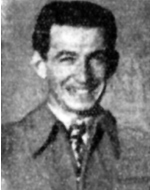Feigenblat, Yechiel
Son of Zippora and Benjamin, was born in 1925 in the city of Pilitsa, Poland. With the outbreak of World War I, after finishing elementary school and the German invasion, he fled to the forests and joined the partisans. In 1942 he returned secretly to his town and found it empty of Jews, and no remnant remained from his family. He was caught by the Germans, taken to a labor camp in Germany and rolled from camp to camp until liberation. He was one of the first to devote himself to Zionist activity among the surviving remnant of Germany and was one of the activists for the unification of all parties with one aspiration: immigrating to Israel. He was one of the first kibbutzniks to join the “Ichud” (Union of Pioneer Youth) group near Frankfurt am Main, and was one of the first kibbutzniks to immigrate to Eretz Israel. The British, with all the immigrants to Cyprus, where he did not lose his temper and his usual saying: “Our hope has not yet been lost.” On December 22, 1946, he returned to Israel, first in Rishon Letzion and later in Tel Aviv. At the outbreak of the War of Independence, he enlisted with the former, served in the Carmeli Brigade, was sent to the Sea Guard near Acre and participated in Operation son of-Ami for the liberation of the Western Galilee. The ship “Hannah Szenes”, which became the Israeli navy ship, went from Haifa to the Shavei Zion beach in the Western Galilee, and from there they attacked the Arab village of Samariya on the Acre-Nahariya road. Was taken to the hospital in Nahariya, underwent surgery twice, suffered severe suffering and died five weeks later, on 21 June 1948. He was laid to rest at the military cemetery in Nahariya, “Survivors of the last survivor are survivors of the Holocaust who remained the last survivor of their nuclear family (parents, brothers, sisters, sons and daughters), who experienced the Holocaust in the ghettos and / or the concentration camps And / or fleeing and / or hiding in territories occupied by the Nazis and / or fighting alongside members of the underground movements or partisans in the Nazi-occupied territories who immigrated to Israel during or after World War II, wore uniforms and fell in the Israeli army.
